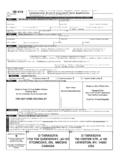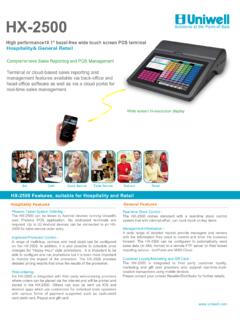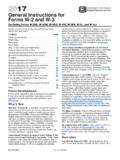Transcription of ATO register of private binding rulings – subject …
1 Client Information Bulletin Page 1 Autumn 2005 Contents 1 > ATO register of private binding rulings subject searches > International Financial Reporting Standards (IFRS) > Resolve to make 2005 a great year for your business 2 > Common Rule coverage comes to Victoria > Keeping it in the family succession planning > Proposed changes to the Victorian Long Service Leave Act > Occupational Health and Safety Act 2004 3 > Tax rulings and determinations > Treasurer s Tax Reform package 4 > Superannuation record keeping requirement > Your superannuation guarantee reporting requirements as an employer ATO register of private binding rulings subject searches The ATO has enhanced its register of private binding rulings to enable online searches by subject matter. The register contains more than 46,500 edited versions of ATO responses to private requests for written binding advice.
2 For further information visit International Financial Reporting Standards (IFRS) International Financial Reporting Standards (IFRS) commenced on 1 January 2005. Please contact your accountant for further information. Resolve to make 2005 a great year for your business According to Victoria s former Minister for Small Business, Marsha Thomson, Australia is experiencing a period of strong growth and Victoria, in particular is leading the nation in creating new businesses. Make a resolution to ensure your business is even more productive, rewarding and successful in 2005 using the following checklist outlined by the Minister for Small Business. Why not resolve to: 1. Improve your business skills 2. Find a business mentor or coach 3. Develop new strategies to grow your business 4. Participate in partnering and networking opportunities 5. Develop a business or strategic plan 6.
3 Consider business expansion opportunities 7. Investigate export opportunities 8. Raise the profile of your business by entering a business awards program 9. Consider the benefits of e-commerce 10. Know your legal rights and responsibilities as a business owner. For more information on any of the points mentioned above visit Common Rule coverage comes to Victoria Most employers and employees who formerly operated under Schedule 1A of the Workplace Relations Act 1996 will automatically become subject to a common rule award during 2005 depending on their industry classification. Industry sectors with a common rule award coverage from 1 January 2005 include Clerical and Administrative, Commercial Sales and Hospitality. If a workplace is currently covered Client Information Bulletin Page 2 by Schedule 1A, the minimum employment conditions may be improved after 1 January 2005.
4 Schedule 1A conditions will no longer apply once a common rule is declared in a particular industry. Workplaces or employees already covered by federal awards, certified agreements or Australian Workplace Agreements are not affected. For full detail of awards whose coverage has been extended visit Keeping it in the family succession planning Are you planning to retire from a family business or know someone who is? One of the most significant challenges to the owner of any family business is planning for the future and how to best transfer share ownership to the next generation, to ensure the business continues and provides family security for surviving family members. Business owners should also consider estate planning issues if there are children who are inactive in the family business. Without some form of succession plan there is a risk the business can become paralysed when the owner departs, particularly if it is unexpected.
5 By not planning ahead owners run the risk that their business will not get to the next generation, or will lead to debate and stress to all parties. Many family business owners do not consider the implication of share ownership or succession planning because they are too busy building their business. In most instances business owners leave their estate and business for the benefit of their spouse, with provision for it to be distributed equally among the children when their spouse passes on. This approach however can lead to disaster depending on who participates in the business. A participating family member working in the business could believe it unfair to share equally with a family member employed outside of the business. Removing yourself from the business what are some of the options? To minimise stress and disagreements between siblings the business owner needs to differentiate between active and passive family members.
6 This may include: > Leaving a majority of shares to the active members of the business those who have participated and helped build the business > Having the business valued and selling the business to their children. For owners that do not want to risk their retirement security and are not sure that their children want, or are able to run the business successfully the following options are available: > A leveraged buy out whereby the business borrows the money to buy out the owner. In order to do this there must be sufficient cash flow to service the new debt, and the owner may be subject to tax on the gain, as though the business were sold to outsiders. This approach ensures the owner is secure with cash, and the children can continue the business, for better or worse. For owners that have both active and inactive family members consider: > Leaving assets to inactive members instead of dividing the business in equal parts.
7 This could include real estate or security investments. > Providing life insurance options small amounts of shares can be gifted to the active children and the company can take out a life insurance policy on the life of the owner. On the owner s death, the proceeds of the life insurance can be used to redeem the remaining shares from the owner s estate. This then leaves the business in the hands of the active children while also providing enough cash for those who are inactive. Taking care of yourself To ensure the business owner is not reliant upon the family business to supplement their income in retirement they need to consider if they and their spouse have significant assets outside of the business to guarantee their own security following their retirement. This means that their security is not dependent on the future success of the business they have passed on to their children.
8 Succession planning for a family business is not easy however planning ahead can lead to significantly less stress down the track for everyone. So get planning NOW! Client Information Bulletin Page 3 Proposed changes to the Victorian Long Service Leave Act The Victorian State Government has announced a proposal to allow all Victorian Workers* to access Long Service Leave after 10 years. A discussion paper has been issued and is available at * The Construction Long Service Leave Act 1997 is not included in the proposal Occupational Health and Safety Act 2004 Most of the provisions of the Occupational Health and Safety Act 2004 come into effect 1 July 2005. The Act creates equality between all businesses, no matter what size, by making officers of large businesses, as well as small businesses, accountable. The language of the Act itself is more easily understood and eliminates some of the ambiguities of the old Act.
9 For example, references to "health" in the Act covers psychological health as well as physical health. Paperwork will not increase. Specifically some of the major changes are: > New duty on designers of workplaces (01/07/2006) > Increased duty on employers to consult > Duty to notify incidents > Introduction of deputy representatives > Increased training for OHS representatives and deputies > Increased protection for representatives against discrimination and "harm" > Introduction of right of entry to workplaces for Authorised Representatives of Employee Organisations > Introduction of review of decisions > Alternative sentencing options, increased penalties, and introduction of potential prison sentences when breaches occur. Under the Act, WorkSafe Victoria will provide guidance for employers and workers to assist in the transition to the new era of occupational health and safety.
10 WorkSafe's aim is to foster co-operation between all parties, rather than the "big stick" approach. Additional information is available at: Tax rulings and determinations TR 2004/16, Income tax: plant in residential rental properties The final ruling on income tax: plant in residential rental properties differs little to the draft ruling released in mid 2004. The key point to note is that elements that form part of the setting of the rent-generating activities are not plant. Further, an item that is a fixture can be neither plant nor articles. The ruling also deals with the meaning of machinery, which affects the scope of plant. For example: > Stoves, ovens, cooktops and hot water cisterns are plant > Kitchen cupboards and built in robes are not plant and not depreciable as plant > The power unit, hose and brush of a ducted vacuum cleaner is plant however the ducting is not > Carpets and curtains can be depreciated.




